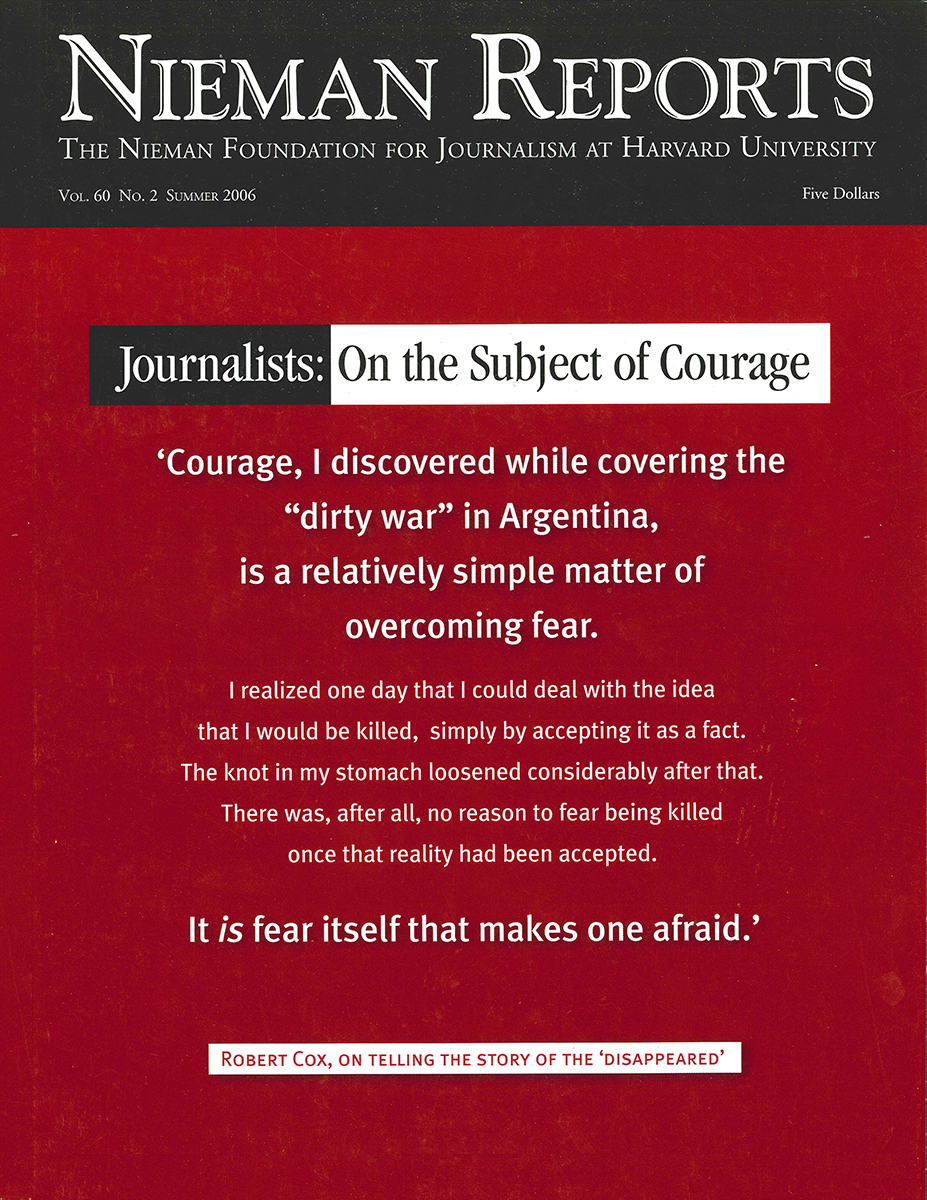When most of the news media misreported that a dozen men had survived the coal mine disaster in Sago, West Virginia last January, critics reflexively pointed fingers at the usual suspects: the demands of the 24/7 news cycle, the erosion of attribution, and just plain sloppy reporting. For the audience, it probably seemed like just another screw up by an industry that is burning through its credibility. But if you were working in the mud and misting rain in Sago early that morning, the truth was more complicated and the lessons deeper.
Communications technology was both a boon and a curse. Cell phones allowed us to report directly from a remote mountain hollow, but they also contributed to the confusion. Conversely, the same technology that allowed news organizations to beam the wrong information around the world in seconds also made it easier to correct later.
The limits of the oldest and most earth-bound medium, the print newspaper, were painfully clear. CNN could instantly change its story on air or on its Web site. But there was no refresh button to change the embarrassing headlines — “They’re Alive” and “Miracles Happen” — on newspapers as they landed in driveways later that morning.
And when the story seemed to take a U-turn, we reporters should have been more skeptical. If more of us had stuck with the old adage — write what you know, not what you think you know — everyone would have been better off.
The Beginning
How did this story get so messed up? It was a low-tech/hi-tech debacle, a game of “whisper down the coal mine” that ricocheted across the world. The story was transmitted through a breathtaking array of communication devices: hand-held radios, mobile phones, church bells, satellite trucks, and — finally — notes scribbled in the dark.
It begins a little before midnight, two days after New Year’s. After more than 40 hours, rescuers find the men about two miles inside the mine. Eleven are dead, already cold to the touch, with rigor mortis setting in. One is barely alive.
But that’s not the first message the rescuers send to the surface. They simply say they have found “12 individuals” and one is alive. They are using radios that can’t transmit through the rock. So they send the message through five underground relay stations. Because of the risk of carbon monoxide poisoning, some of the rescuers have to repeat the words through face masks.
By the time the message reaches the surface, it has morphed into, “Twelve Alive!”
In an earlier time, before mobile phones, the confusion might have remained there, at the mouth of the mine. But the mine company is broadcasting the radio traffic over speakers. Rescue workers nearby hear it and begin dialing their cell phones.
About 300 yards away — across a river, railroad tracks, and a police roadblock that keeps reporters at bay — a mine employee answers. He’s at Sago Baptist Church, where hundreds of friends and families of the trapped miners are waiting. Most have given up hope.
The news of survivors sweeps through the sweltering sanctuary. In celebration, someone begins ringing the bells in the steeple. Reporters are standing down the hill, corralled by police in a small, muddy area, warming themselves by open fires.
A gaggle rushes to the church. Family members say a mine foreman has told them that a dozen men have survived. West Virginia Governor Joe Manchin — apparently relying only on the families’ account — gives a thumbs-up.
Anderson Cooper goes live on CNN.
The Confusion Deepens
The coal company has no professional spokesperson and no one on-site to confirm or deny the story. Officials with the federal Mine Safety and Health Administration are also at Sago. But they give no briefings and are essentially invisible.
Newspaper reporters phone their desks. Editors change leads and headlines for the final edition. Some cover themselves by attributing the information to families. Others state it as fact.
I’m sitting in a hotel room 40 miles north, sending audio tape back to headquarters for National Public Radio’s “Morning Edition.” After I see CNN report the news, I call a colleague on the scene, Tom Vanden Brook of USA Today.
“Is this for real?” I say.
Only that afternoon, the coal company had tested air inside the mine and found fatal levels of carbon monoxide. I’d covered mine disasters before in Kentucky. They almost always end badly. I’m all but certain these men are dead.
“The families say they’re alive,” says Tom. “You should get down here.”
I jump in the car and head south. News of survivors snowballs.
On the way back to the mine, I pass signs outside restaurants that hours earlier had read: “Pray for Our Miners.” Now, they say: “Our Miracle Miners.”
When I get to the mine road, state troopers have blocked it. They are keeping it clear for the ambulances that will take the survivors to the hospital. I hike three miles back to the scene in the dark with a Fox News producer. He predicts the survivors will sell their rights to the story, and we’ll be watching this as a movie of the week.
None of us are as keen as we might be. Most have been covering the story for two days straight with little or no sleep. Some people have been sleeping in their SUV’s.
Back at the scene, I start working the story again, gathering tape from family members and waiting for confirmation from the coal company. I stay off the air, partly because I don’t have a pressing deadline, partly because I feel I don’t have the story.
Outside the mine, medical staff are preparing for survivors. Kevin Stingo works as a nurse at a nearby hospital. Later, he describes the scene to me when he arrived at the mine:
“One of the ER nurses was standing outside the tent on the cell phone, and she said, ‘We’ve been told that all 12 are alive and that they’re going to be bringing them out in stages.’ So they were basically going to give us the worst of the patients. So we started getting ready, warmed up IV fluids, priming IV lines, getting IV equipment, monitors out.”
Later, a different woman wearing a nurse’s uniform and an I.D. tag walks up to a CBS satellite truck, which is on the other side of the police line. She tells CBS correspondent Sharyn Alfonsi that she’s been treating the men outside the mine. She gives their medical conditions in detail. The “nurse,” of course, is making the story up. Alfonsi, who is preparing for a morning report, never broadcasts the information.
Later, a Red Cross volunteer tells me that high profile disasters like Sago often attract mentally unstable people with rescue fantasies. But in a dark and muddy West Virginia hollow, how would you know?
Back at Sago Baptist, everyone is under the same impression as the phantom nurse. They are singing hymns and making room in the pews for a reunion with their loved ones. They expect the miners to walk through the front door any moment.
Instead they get Ben Hatfield, the mining company president, flanked by state troopers. Hatfield gives them the bad news. All but one are dead. He gets out as fast as he can.
People trickle out of the church, heads down, striding past reporters.
We learn the story that most of us have reported is completely wrong.
Questions Remain
Why weren’t we more skeptical? There were sources — family members, the governor, the phantom nurse — that seemed credible. All the physical cues — the ringing bells, the ambulances — reinforced the story.
But most of us suspended disbelief when we should have kept asking the nagging question: How did these guys survive? Maybe we got caught up in the emotions. Facing the tragedy of 12 dead men — fathers, brothers, sons — we were moved by a miracle, even if it defied logic. And perhaps we were victims of our own humanity. It’s a charge you don’t hear leveled at reporters very often.
When the miners’ bodies were brought to the surface, people found notes they had written while they were dying. One was from Junior Hamner, a shuttle car operator with 26 years in the mines. He left the note in his lunch box for his wife and daughter. In a day filled with confusion and miscommunication, it was the clearest and most eloquent message.
“Hi, Deb and Sara. I’m still OK at 2:40 p.m. I don’t know what is going on between here and outside. We don’t hear any attempts at drilling or rescue. The section is full of smoke and fumes, so we can’t escape. I just want you and Sara to know I love you both and always have. Be strong and I hope no one else has to show you this note. I’m in no pain, but don’t know how long the air will last.”
Frank Langfitt, a 2003 Nieman Fellow, covers labor and the workplace for National Public Radio.



